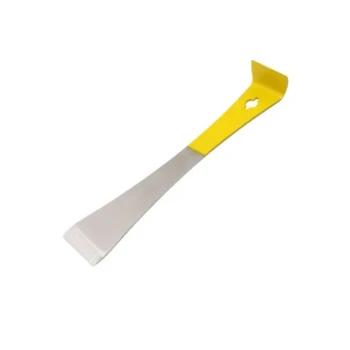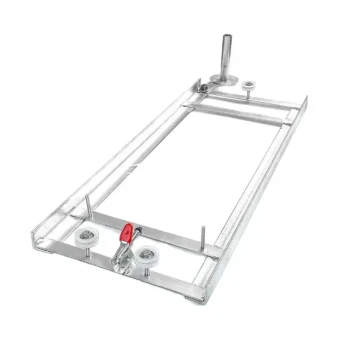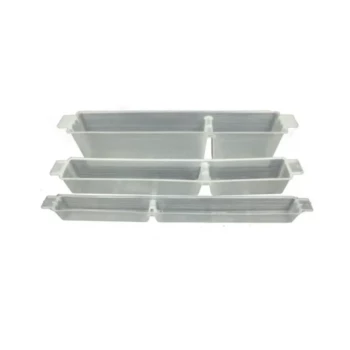Your local climate is the single most important factor in choosing between a screened or solid bottom board for your beehive. The decision comes down to a fundamental trade-off: a screened board prioritizes ventilation for hot and humid conditions, while a solid board prioritizes heat conservation for colder climates. Understanding this balance is key to supporting your colony's health throughout the year.
The choice between a screened and solid bottom board isn't about which is "better," but which tool best helps your colony manage its internal environment. Your primary goal is to select the board that provides the right balance of ventilation, moisture control, and temperature regulation for your specific location.
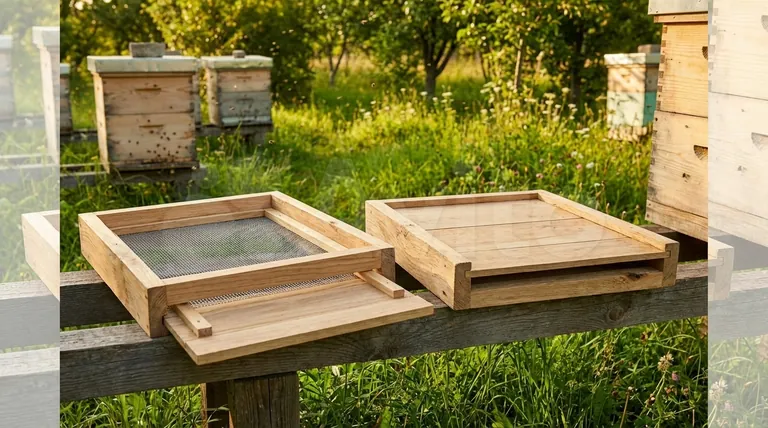
The Role of the Bottom Board
A bottom board is more than just the floor of the hive; it is a critical component for regulating the colony's internal environment.
The Hive's Foundation and Entrance
The bottom board serves as the structural base for the entire hive. When a hive body is placed on it, the board creates the main entrance and exit, which acts as a takeoff and landing platform for foraging bees.
To ensure hive health, the entire hive should be placed on a stand or firm surface that raises it off the ground. This prevents moisture from wicking into the wood and promotes longevity. A slight forward tilt also ensures any rainwater drains out rather than pooling inside.
Regulating the Internal Environment
The bottom board’s most vital function is to help the bees control airflow and temperature. Bees work tirelessly to maintain a stable internal climate, and your choice of bottom board can either help or hinder their efforts.
An entrance reducer can be used with either type of bottom board to shrink the entrance size. This is crucial for small colonies that need help defending against intruders and for all colonies during cold weather to reduce heat loss.
Screened vs. Solid: A Climate-Driven Decision
The primary difference between the two board types is how they handle airflow. This makes climate the deciding factor.
The Case for Screened Bottom Boards
Screened bottom boards feature a section of sturdy hardware cloth or screen that allows for significant airflow. This makes them the superior choice for hot and humid climates.
This continuous ventilation helps prevent the colony from overheating on hot days and, critically, allows excess moisture to escape. Reducing internal humidity is essential for preventing mold and mildew from growing on the comb.
A secondary benefit is passive pest control. Varroa mites, a major threat to honeybees, can sometimes lose their grip and fall off a bee. With a screened bottom board, these mites fall through the screen and out of the hive entirely.
The Case for Solid Bottom Boards
A solid bottom board is a simple, solid piece of wood that forms the hive floor. Its primary advantage is heat retention.
In regions with cold winters, a solid bottom helps the colony conserve the heat it generates. By minimizing drafts and heat loss, the bees expend less energy (and consume less honey) to keep their winter cluster warm, significantly improving their chances of survival.
Understanding the Trade-offs
Neither option is a perfect solution for all scenarios. Being aware of the limitations of each is critical for effective hive management.
The Downside of Screened Boards in Winter
The excellent ventilation of a screened board becomes a liability in cold weather. The constant airflow can make it impossible for the colony to retain enough heat, causing unnecessary stress and increasing winter honey consumption.
Many beekeepers mitigate this by using a removable insert or "closure board." This is a solid panel, often made of plastic, that slides into a slot under the screen, effectively converting it into a solid bottom board for the winter months.
The Risk of Solid Boards in Summer
In hot and humid weather, a solid board's lack of ventilation can lead to problems. The colony can overheat, and moisture from the bees' respiration can become trapped inside, creating an ideal environment for mold and other pathogens.
Overheating can also lead to "bearding," where a large number of bees cluster on the outside of the hive in an attempt to cool down, reducing the workforce available for in-hive tasks.
Mite Management Nuances
While a screened board helps mites fall out of the hive, a solid board is a better tool for monitoring mite levels. By placing a "sticky board" (a sheet coated in a non-toxic sticky substance) on the solid bottom board for a set period, you can count the fallen mites. This data provides a crucial snapshot of the infestation level within your colony, allowing you to treat it effectively.
Making the Right Choice for Your Bees
Your decision should be a direct response to your local climate and beekeeping goals.
- If you live in a hot, humid climate: A screened bottom board is the standard and most effective choice for year-round hive health.
- If you live in a region with cold winters: A solid bottom board helps ensure overwintering success by prioritizing heat conservation.
- If you want maximum flexibility: A screened bottom board with a removable insert gives you the best of both worlds, allowing you to adapt the hive from summer to winter.
- If your primary focus is precise Varroa monitoring: A solid bottom board paired with a sticky board provides the most accurate data for making treatment decisions.
By matching your bottom board to your climate, you provide the foundation your bees need to regulate their own home and thrive.
Summary Table:
| Climate Type | Recommended Board | Key Benefits | Key Considerations |
|---|---|---|---|
| Hot & Humid | Screened | Enhanced ventilation, moisture control, passive mite control | Can cause heat loss in winter; use removable insert for cold months |
| Cold Winters | Solid | Superior heat retention, energy conservation for bees | Limited summer ventilation; risk of overheating and moisture buildup |
| Variable/All-Season | Screened with Insert | Maximum flexibility; adapts to seasonal changes | Requires manual adjustment; slightly more complex management |
Ready to equip your apiary with the right bottom boards for your climate?
HONESTBEE supplies durable, climate-appropriate beekeeping equipment to commercial apiaries and distributors. We help you maximize hive health and productivity with our wholesale-focused operations.
Contact us today to discuss your beekeeping supply needs!
Visual Guide
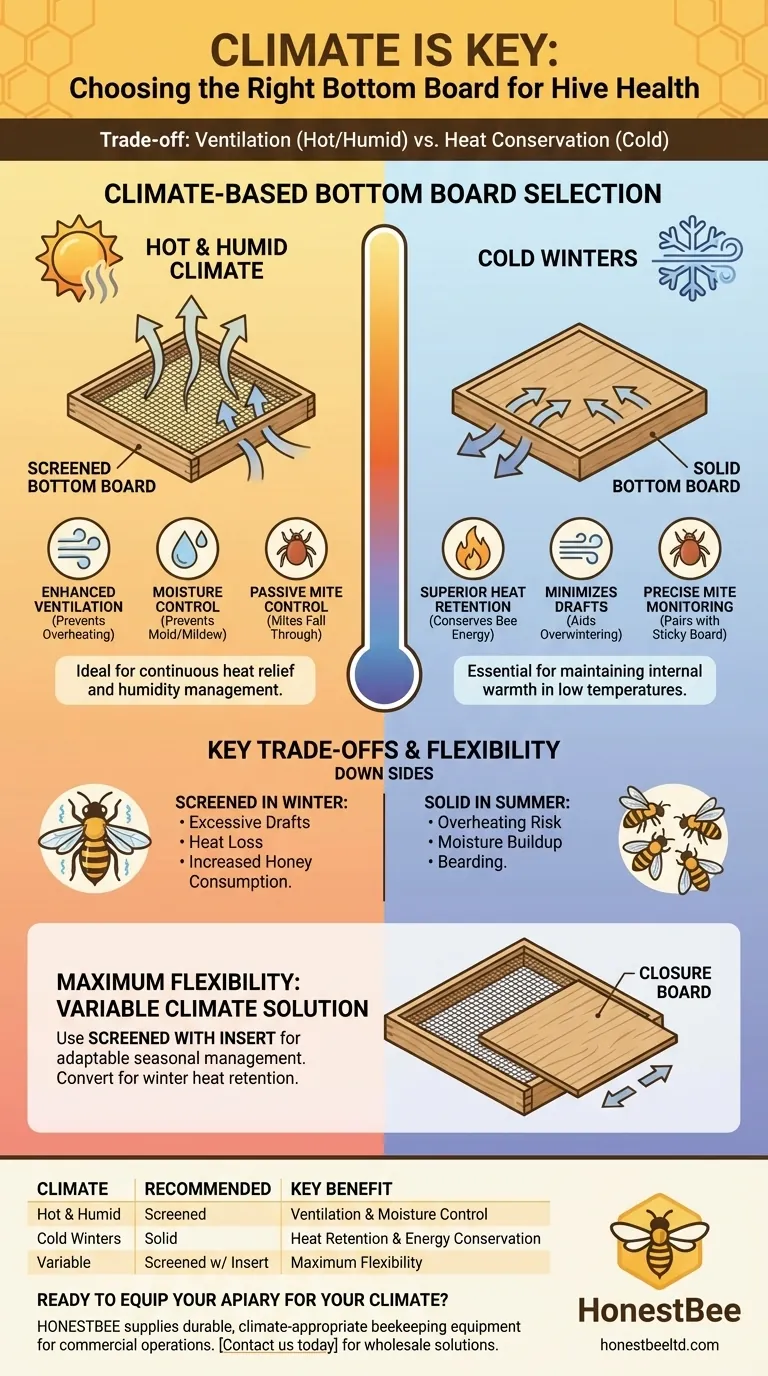
Related Products
- Langstroth Solid Bottom Board for Beekeeping
- Langstroth Screen Bottom Board for Beekeeping Wholesale
- Australian Pine Wood Langstroth Screen Bottom Board for Wholesale
- HONESTBEE Classic Pry Bar Hive Tool with High Visibility Finish for Beekeeping
- Professional Ant-Proof Beehive Stand with Integrated Moat for Beekeeping
People Also Ask
- What are the characteristics of a solid bottom board? A Guide to Hive Foundation & Climate Control
- What is the suggested approach for choosing hive boards if you have only 1 or 2 hives? Test Both Types to Find Your Perfect Fit.
- How do honeybees adapt to different bottom board types in terms of temperature regulation? Optimize Your Hive Climate
- What is the purpose of a solid bottom board in a hive? Essential for Winter Survival & Insulation
- How is the solid bottom board constructed to ensure durability? Built for Longevity with Quality Wood & Beeswax



